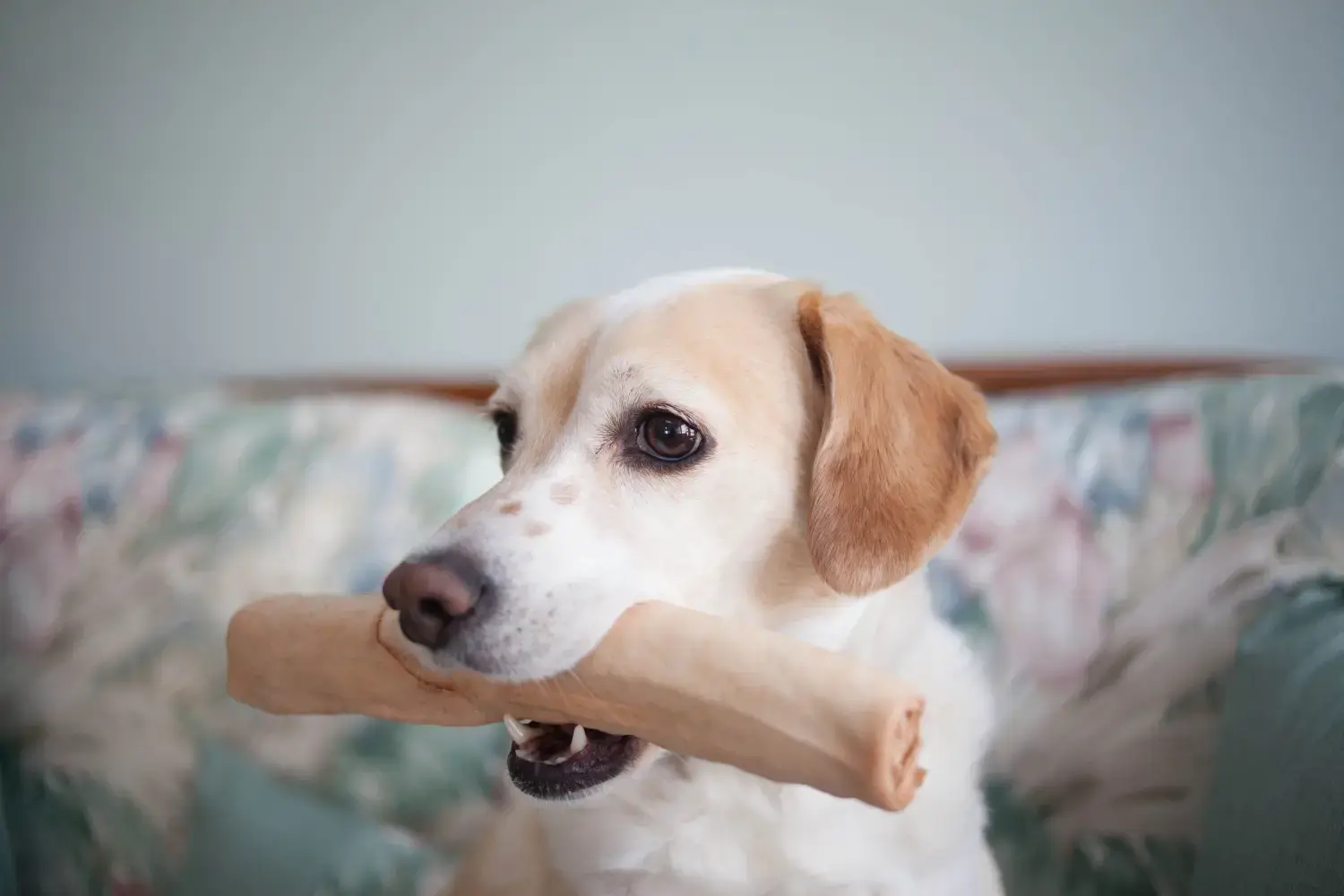
If you’ve ever felt uneasy about traditional rawhide chews but weren’t sure where to turn, you’re in good company. Check out our favourite rawhide alternatives to give your dog a safer and more nutritious chew.
Many of us love treating our dogs to something delicious and long-lasting, but the potential choking hazards, digestive problems, and chemicals used in rawhide have us thinking twice.
You want to keep Fido happy and meet your pup’s chewing needs, but you also want to ensure you only provide safe chewing opportunities. Luckily, there’s an ever-growing selection of alternatives to rawhide for dogs that let you spoil your pup without the worry.
Many rawhide alternatives for dogs will offer similar benefits and fewer risks than traditional rawhide chews. You can find natural alternatives to rawhide made from single-ingredient sources and innovative rawhide alternative dog chews designed to entertain your pet for hours.
In this guide, you’ll discover ten most popular rawhide bone alternatives that can keep your dog happy, healthy, and safely occupied.
What are Rawhide Alternatives for Dogs?
A rawhide alternative is not a singular type of chew. Instead, it's a broad classification that covers many types of natural chews that are designed to offer the same benefits as rawhide, but with fewer risks.
Chewing is an important part of your dog's dental health and is a great way to keep them occupied and satisfied. While rawhide chews for dogs have long been the go-to choice of dog chews, many pet parents are uncomfortable with the significant risks that can be associated with rawhide.
Many of the best alternatives to rawhide for dogs will be easier to digest, making them a safer option. In addition to how the chews are consumed, most natural rawhide alternatives are made using safe and chemical-free dehydration, smoking, or freeze-drying techniques.
While no chew is without risk, our top rawhide bone alternatives can give you more peace of mind when selecting the right chews for your pooch.
What are Natural Chews for Dogs?
Natural chews are a broad term that refers to most edible chew treats for dogs. This typically includes a wide range of animal products, but some plant-based chews are available as well. From robust and long-lasting to crunchy and nutritious, natural chews are options most dogs can enjoy and safely consume.
They get lumped together as one type of chew, but in reality there is so much variety that you can be looking at drastically different products with different risks and benefits.
Here are a few popular natural chews:
-
- Bully Sticks
- Raw Bones
- Dehydrated Chicken Feet
- Pigs Ears
- Fish Skins
Each of these chews are very different from each other, so it's important to know what you are looking for in a chew. Ask yourself how long it should last. Does your dog need extra calories from chews? Is it safe for your dog's teeth? Will my dog chew this properly?
Tougher chews like raw bones and bully sticks are better for dogs that need a longer chewing session and can handle the extra calories of a larger and more dense chew. Smaller rawhide alternatives like chicken feet or fish skins are better suited to daintier chewers and smaller breeds.
Check out our full selection of Best Long Lasting Dog Chews to learn more about each type.
What is a No Hide Dog Chew?
Though the concept has been around for a while, no-hide dog chews are becoming more and more popular now that the risks of rawhide dog chews are more commonly accepted. But what is a no-hide chew?
A no-hide chew is a type of dog chew that is meant to mimic the taste, texture, and appearance of a rawhide, giving your dog the rawhide experience without actually having any rawhide in it. There are many brands that offer a non-rawhide chew alternative, but make sure that you aren't replacing one undesirable ingredient for another.
Look for no-hide options that use natural ingredients and avoid unnecessary sweeteners or artificial flavours. Here are a few brands that we think your dog might not mind giving up his rawhide for:
You'll find options for dogs of all sizes, including bully sticks, rolls, and chips in a wide variety of flavours to accommodate preferences and sensitivities. No hide dog chews are gluten-free, long-lasting, nutritious, and, most importantly, a safe alternative to rawhide.
What is a Collagen Chew for Dogs?
One of the newest styles of dog rawhide alternatives is collagen chews. These chews are quickly gaining popularity because of their similarity to rawhide.
Unlike many of the natural chew options you'll see in our list below, collagen chews look and taste more similar to rawhide, making them a preferred option for dogs that are accustomed to eating rawhide already.
The reason they look so similar is because they are. Like rawhide, collagen is a type of skin, technically. Unlike rawhide, collagen comes from the inner layer of tissue and is much more digestible than rawhide made from whole hide.
Collagen also goes through a natural manufacturing process compared to rawhides, which often require harsh chemicals to process.
10 Safe Rawhide Alternatives for Dogs
1. Bully Sticks

One of the top rawhide alternative dog chews out there is the bully stick. These are made from the dried muscle tissue of cattle—often known as the bull’s pizzle.
In recent years, bully sticks have become one of the most popular, natural chews for dogs because of their bold meaty flavour and dense long lasting texture. It softens as they chew and can aid in helping your dog remove bacteria that hide in the back of their mouth and at the gum line.
They are offered in different lengths, thicknesses, shapes, and sizes to suit each individual dog's chewing style. They are suitable for dogs of any age but are especially popular for teething puppies with sensitive teeth and gums.
Compared to rawhide, some bully stick options are more expensive, so it's a good idea to include bully sticks as part of a natural chew rotation rather than using it as your dog's daily chewing choice.

2. Himalayan Yak Chews
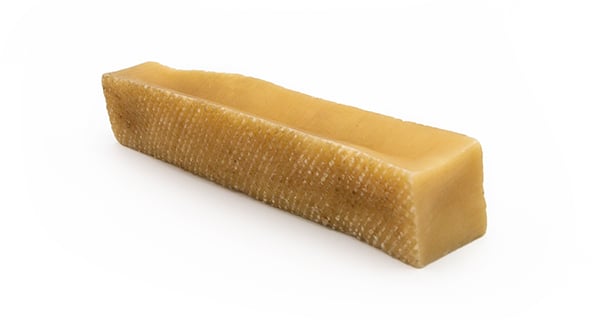
Another option that’s gaining popularity is yak cheese chews, sometimes called Himalayan dog chews. They’re crafted using just a few simple ingredients—yak or cow milk, salt, and lime juice—which makes them a standout among natural alternatives to rawhide.
Yak cheese chews, like Eldon's Yak Cheese, are super tough, so many dogs will spend hours working on them. That durability can be a plus, but if your dog has weaker teeth or you notice them chomping down too aggressively, you might want to supervise closely to avoid any risk of tooth damage.
Although these chews can be a bit costly, they’re beloved for their rich, cheesy taste and the fact that they contain no artificial additives.
3. Pig Ears
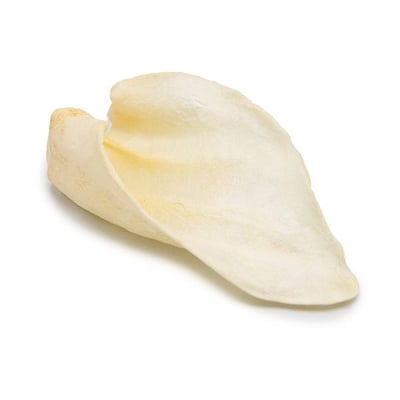
For those looking for something tasty with a softer texture, pig ears might be just what the dog ordered. These are often baked or smoked, resulting in a crispy, chewy treat that’s incredibly appealing to pups. Pig ears, like ValuePack Pig Ears, offer a nice balance: they’re softer than rawhide or bones, yet they can last much longer than a typical biscuit or cookie.
However, they do come with a few considerations. Pig ears can be high in fat, which is tempting for dogs but potentially problematic if your pup is prone to weight gain or digestive issues. They can also leave behind some grease, so you’ll want to keep an eye on your floors and furniture.
Pig ears aren't the only animal ears that dogs can chew. Lamb ears, cow ears, and rabbit ears are all suitable options, and are typically less fatty and greasy. Though they may not be as long lasting, you can choose the protein and size that best suits your dog.
Learn more about pig ear safety and best practices in Are Pig Ears Good for Dogs?
4. Beef Tendons
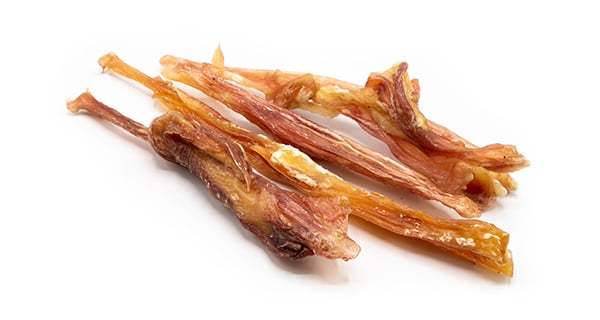
Beef tendons are another solid choice among alternatives to rawhide for dogs. These tendons (sometimes labeled “beef taffy” or “achilles tendons”) are made from the fibrous tissue connecting muscle to bone.
They’re known for being fairly tough, but they break down more easily in the digestive system compared to rawhide. Plus, they’re typically low in fat and high in protein, which can make them a healthier option for many dogs.
The almost stringy texture of beef tendons as they are chewed will allow the chew to sink between teeth as it softens, providing dental benefits of helping to remove stuck debris.
Eldon's Beef Tendons are fully long-lasting, digestible, and are suitable for all dogs, and while they aren't quite as tough as bully sticks, they are still a suitable chew for smaller breeds and less aggressive chewers.
5. Fish Skins
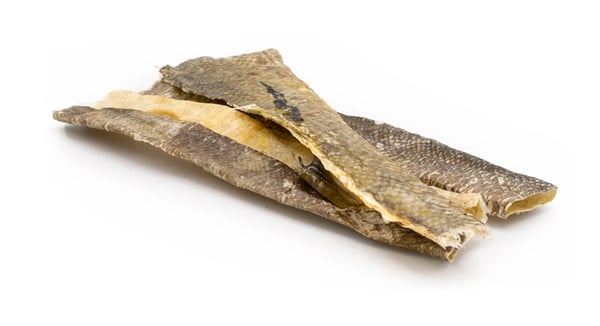
Does your dog love fishy flavors? The bold fishy flavour of fish skins makes them an obvious candidate for rawhide alternatives. Additionally, fish skins are a great source of healthy omega fatty acids, so it's a snack and a nutrition boost in one.
Because the texture tends to be thin and flaky when gnawed, fish skins are often easier on the tummy compared to rawhide, and are much safer on delicate teeth. Icelandic+ offers dried cod skins in a variety of shapes and sizes to allow you to pick the right one for your dog's chewing preferences.
Unlike most of the chews on this list, these are not a long-lasting chew for most dogs but are a great option for dogs that aren't as aggressive with their chews and for small breeds that just can't handle a robust and dense chew like a bone.
6. Antlers and Horns
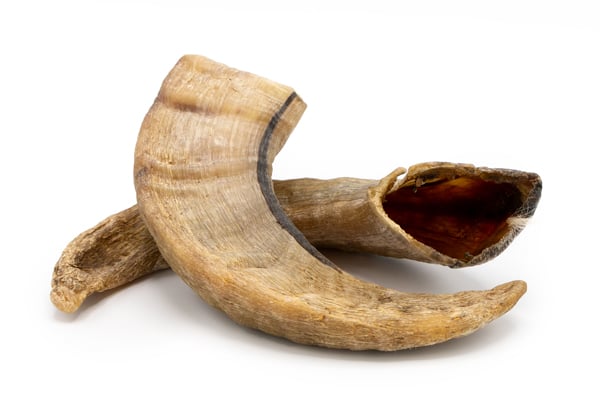
Antlers are one of the most durable natural alternatives to rawhide and are typically sourced from deer or elk after they’ve naturally shed them. They’re packed with beneficial minerals, and many dogs love the challenge of scraping out the marrow.
Because they’re so solid, antlers can last quite a while, making them a potentially cost-effective option for powerful chewers.
Still, that same hardness is also their biggest drawback. Aggressive chewers could risk cracking a tooth if they go at the antler too vigorously. Not every dog appreciates the taste or texture either, so expect some trial and error to see if your pup is a fan.
For dogs that can't handle the density of antlers, lamb horns are another option. Lamb horns are made of Keratin, not bone, making them tough but not hard like bone. As your dog chews, the horn will begin to break down into small enough pieces to swallow digestible pieces.
Icelandic+ Lamb Horns are fibrous, which allows the chew to sort of brush their teeth and gums as they chew. They are also hollow, so you can stuff them with tasty fillings like wet dog food or pet-safe peanut butter.
7. Raw Bones
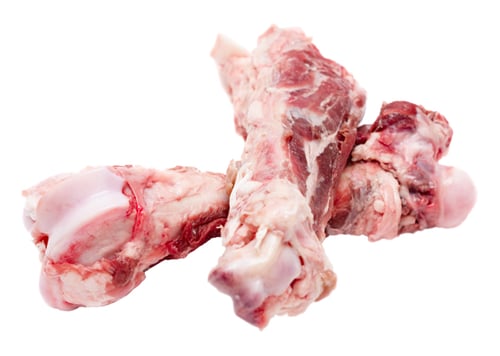
Feeding raw dog bones fights bacteria on two fronts. The action of long-lasting chewing will loosen bacteria, especially in the harder-to-reach areas at the back of their mouth, and the enzymes from the raw meat will fight off oral bacteria and freshen your dog’s breath.
Raw bones come in a wide variety of options. Some are meant to be consumed and are packed with healthy calories and nutrients, like Puppy Love Raw Turkey Necks, while others are meant for long chewing sessions, such as Big Country Raw Raw Beef Patella Bones.
Though raw bones might seem scary, it's important to note that raw bones are a much safer option than cooked bones. Bones that have been baked or smoked can be very brittle, leading to sharp splinter breaking off as your dog chews.
Learn more about raw bone safety in A Guide to Feeding Raw Bones for Dogs.
8. Beef Esophagus
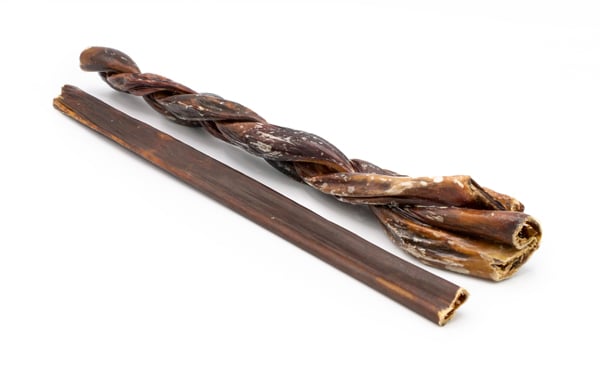
For dogs that love to chomp, this natural chew provides a satisfying crunch for your dog's chewing sessions. Made of the tubular, smooth muscle of cow esophagus, this chew resembles bully sticks in colour and odour, but softens more similarly to a rawhide chew.
One of the benefits of this single ingredient chew is that it can be stretched, twisted, and cut into a variety of thickness, lengths, and shapes to provide a chewing option that best suits your dog's chewing style. Check out popular options like Eldon's Angus Beef Strips or Silver Spur Esohphagus Sticks to find the right rawhide alternative chew for your pooch.
They are made of the pure beef esophagus, so they are high protein, low fat, and easy on the tummy. They are a great choice for dogs that are trying to lose weight and for those with sensitive tummies.
9. Beef Trachea
We've covered a lot of weird animal parts in this post, and this natural rawhide alternative is no exception. Beef trachea is a cartilaginous tube-shaped chew that dogs love both the flavour and texture of. It's not robust like some other chews, but the shape and size still make it a fun and long-lasting option.
Though there isn't as much variety with trachea, you can find them in different sizes to suit your dog. They are also safe for puppies, senior and every pooch in between. Eldon's Beef Trachea is made from grass fed beef and is gently air-dried to preserve flavour and nutrients.
The shape also allows you to stuff it with your dog's favourite fillings or food to make it a long-lasting feeding option or just a delicious puzzle to keep heir bodies occupied and their brains sprinting. Make one yourself, or try a pre-stuffed one like the Rollover Beef Chewbie.
For smaller breeds and very young pups, Ziwi Peak Lamb Trachea is another great choice. Lamb trachea is much smaller, but still provides a thrilling and mouthwatering chewing experience.
10. Collagen Chews

Collagen sticks come from the inner layer of cow skin—sometimes called “corium”—which differs from rawhide in both processing and digestibility. These sticks often break down more smoothly in a dog’s stomach, and they may even offer some joint benefits because collagen can support cartilage and other connective tissues.
While collagen sticks can last a decent amount of time, they’re typically not as indestructible as some of the harder chew options. You’ll also find that high-quality collagen sticks can vary widely in price, so it’s a good idea to shop around.
Pure collagen chews, such as Treatly Braided Collagen Chews and Red Barn Collagen Sticks, are going to be very close in appearance and texture to rawhide.
Another popular option for dogs that love rawhide is no hide chews. These collagen-based chews offer many of the same benefits of collagen chews, but typically have a few more ingredients, like real meat, to offer that extra burst of flavour that dogs love.
For dogs that are already rawhide obsessed, hide free alternatives like Fieldcrest Farms Nothin' to Hide offer a flavour, shape, and texture similar to rawhide, that are much easier to digest.
It's important to note that no chew is without risk, so proper supervision and offering the most appropriate type of chew is still key to keeping your pet safe while chewing.
Choosing the Right Rawhide Bones Alternative for Dogs

Every dog is different, so when evaluating alternatives to rawhide for dogs, think about factors like size, age, and chewing habits. For instance, a teething puppy might need something softer and easier on emerging teeth, while an older dog with sensitive gums may enjoy gentler options like fish skins or sweet potato chews.
Also, always consider whether the chew fits your dog’s diet—treats should generally make up no more than about 10% of your pup’s daily calories. If you’re unsure whether a certain chew is right for your dog, your veterinarian can help guide you toward natural alternatives to rawhide that will meet your pet’s needs without upsetting their stomach or waistline.
No matter which rawhide alternative dog chews you choose, remember that supervision is key. Even the safest treat can present a choking hazard if your dog manages to tear off a large piece. And if a particular chew seems to be causing any digestive trouble—or just doesn’t appeal to your dog—there are plenty of other rawhide alternatives for dogs to explore.
No chew is without risk. No matter the type, any chew that is chewed improperly, swallowed whole, or not the appropriate size for your pet can be a choking hazard.
Follow these strict rules when feeding rawhides or any alternatives to your dog:
-
- Always Supervise: No matter how experienced your dog is or how safe the chew is, you should always supervise your dog with chews.
- Choose the Right Size: When selecting a size for your dog, you can never go too big a layer, but it’s dangerously easy rawhide alternatives for dogs to feed a chew that is small enough.
- Watch for Gulping: Dogs that tend to gulp treats, or have gluten-free digestive conditions, should take extra care with natural dental chews. Large pieces may not break down or could risk damaging the softer tissues along their digestive issues tract or digestive tract.
- Watch the Calories: Always feed chews in moderation. Even low-fat chews add calories. Make sure you are balancing dental chews with their regular diet and exercise. This will prevent your dog from packing on grain-free pounds or running into digestive issues or digestive tract.
We can't stress enough that you should never leave your dog unattended with a chew. Monitoring them ensures their safety and also helps you understand how they chew so that you can offer the safest dog chews and best natural chews to improve their dental health.
Frequently Asked Questions Rawhide Questions
Are rawhide alternatives safe for all dogs?
While many rawhide alternatives are safe, choosing options appropriate for your dog's size, chewing habits, and dietary restrictions is essential.
Can rawhide alternatives cause allergies in dogs?
Dogs with food sensitivities or allergies may react to certain rawhide alternatives, especially those with added flavourings or ingredients.
Are these rawhide alternatives safe for puppies?
Most of these options can be safe for puppies, provided you pick a chew that matches their size and is gentle on developing teeth. Softer choices like fish skins or sweet potato chews can be a good place to start.
How often can I give my dog a rawhide alternative chew?
It varies by product and your dog’s diet, but many items like bully sticks or collagen chews are given a few times a week. Just monitor how many extra calories your pup is taking in and adjust accordingly.
Do rawhide alternatives still help clean my dog’s teeth?
Absolutely. Many of these options—such as tendons or dental sticks—can help scrape plaque. Still, no chew replaces the effectiveness of regular brushing or professional cleanings.
What if my dog swallows a piece of a rawhide alternative?
If it’s a very digestible chew, like collagen or a bully stick, your dog may pass it without issues. Keep an eye on them for any signs of discomfort or distress, and call your vet if you notice anything concerning.
Which is the longest-lasting rawhide alternative?
Antlers and raw bones tend to last the longest, but they can be riskier for aggressive chewers. Bully sticks and yak cheese chews often strike a nice middle ground between durability and safety.
Can senior dogs have rawhide alternatives?
Yes! Just make sure to choose options that won’t be too hard on aging teeth. Softer treats like pig ears or sweet potato chews can be particularly good for seniors.
.png?width=200&height=66&name=logo%20(1).png)









.jpg)
